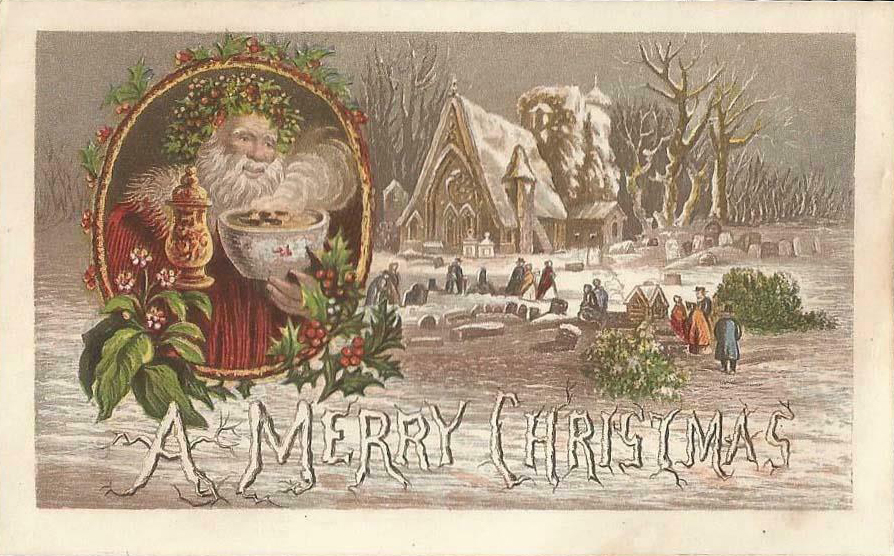History of Christmas Cards
Christmas Cards Become Popular
Page Three
As the postal system developed and improved, people liked the idea of sending cards through the mail. With the growth of interest in Christmas cards a new industry was created. Considerable improvements in printing and engraving methods came with the development of the steam printing press. By the 1850s the improved printing techniques allowed cards to be inexpensively produced, and in multiple colors. Sales figures were as quick to rise as were the number of designs of cards. Popularity of cards grew so quickly that by the 1880s sales figures were in the millions. Christmas cards were usually distributed through booksellers and stationary shops. In the 1880s they could be found for sale in tobacconists and toy shops, and many drapery shops. The Printing Process
The card on the right is hand dated 1857 and features Father Christmas in an insert over looking a snow covered church. To produce multiple color images several stones had to be used, one for each color. The print would have to make multiple passes through the process, one for each stone. This required precession. The stones and print had to be aligned exactly right so that the colors was pressed in the correct placement. Otherwise there would be a bleeding over of colors, or a mixing of colors, which produced undesired tones. One technique that lithographers used was to tint the plate with just one or two colors to produce a watercolor tone to the image. This was used frequently for landscape images. Artist still handcolored the lithographs to acquire more detailed coloration. The process called chromolithography extended the range of colors by using multiple tint blocks pressed in sequence. Early chromos are characterized by simple prints with flat areas of color printed side by side. By the late ninth century the process developed and the use of bright, sometimes gaudy, colors was vogue. Chromolithography was an expensive process and usually used for large scale folio works and the printing of illuminated gift books.
This late 1850s - early 1860s card shows a scene from the nativity; the angels appear to the shepherds in the field, proclaiming "Unto you is born a saviour".
| |||||||
 "Good Morning A Merry Christmas To You". Embossed flowers line this scalloped card. The name "MANSELL" is embossed in the lower left corner. This is the firm of Joseph Mansell, London (1850 -1880's), an early publisher of both valentine and visiting type Christmas cards. This card is hand dated on back "Dec 24th 1864". Size 2.5" x 3.75".
"Good Morning A Merry Christmas To You". Embossed flowers line this scalloped card. The name "MANSELL" is embossed in the lower left corner. This is the firm of Joseph Mansell, London (1850 -1880's), an early publisher of both valentine and visiting type Christmas cards. This card is hand dated on back "Dec 24th 1864". Size 2.5" x 3.75".
 The Christmas cards produced between 1860 and 1890 are most collectible today. The early cards were
printed using a lithography process, which beautifully reproduced the colorful paintings of the popular artist
of that time. The artwork was copied onto specially prepared limestone using crayons or greasy inks. The stone
was then wet with water and the portions not covered with the crayons absorbed the moisture. An oily ink was
then rolled over the stone and adhered only to the portions not wet, since the water repelled the oily ink.
The stone was then pressed on paper to produce the image.
The Christmas cards produced between 1860 and 1890 are most collectible today. The early cards were
printed using a lithography process, which beautifully reproduced the colorful paintings of the popular artist
of that time. The artwork was copied onto specially prepared limestone using crayons or greasy inks. The stone
was then wet with water and the portions not covered with the crayons absorbed the moisture. An oily ink was
then rolled over the stone and adhered only to the portions not wet, since the water repelled the oily ink.
The stone was then pressed on paper to produce the image.
 The steam driven printing press and cheaper paper stock helped to reduce the cost of
chromolithography printing process. But in the late 1880's the photographic process was being developed.
This process would eventually replace lithography by the beginning of the twentieth century.
The steam driven printing press and cheaper paper stock helped to reduce the cost of
chromolithography printing process. But in the late 1880's the photographic process was being developed.
This process would eventually replace lithography by the beginning of the twentieth century.